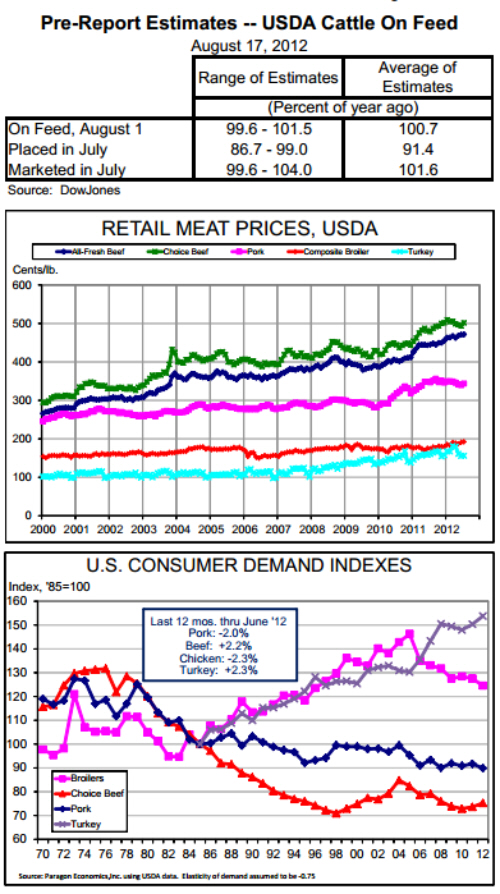



CME: Domestic Meat Demand a Mixed Bag
US - What is worse — high feed prices or poor pasture conditions? We will get a partial answer to that question Friday afternoon when USDA releases its monthly Cattle On Feed report, write Steve Meyer and Len Steiner. The results
of Dow Jones’ pre-report survey of market analysts appear at right.
The ten respondents expect the August 1 inventory of cattle in feedlots
with capacities of 1000 head and more to be slightly higher than last
year in spite of lower placements and higher marketings during July.
Readers should note that Dow Jones throws out the highest and lowest of the individual estimates when it computes the average value.
One factor to keep in mind is the discrepancy that has developed this year between the data for these monthly-surveyed larger lots
and all lots which are surveyed and estimated only twice per year.
Growth of some feedlots that were near the 1000-head capacity
threshold and the exit of some smaller feedlots from the cattle feeding
sector has driven up the survey universe for the monthly report while
reducing the number of “non-monthly” feedlots. The result is higher
monthly numbers simply because of the survey sample. USDA estimates that this has caused the monthly numbers to be 1.5 to 2% higher, year-on-year, than they would have been had the industry’s structure remained constant. July reports illustrated the point with the Cattle On Feed report showing inventories in the big lots 2.7% higher than
last year while the Cattle report showed inventories in all lots up only
0.8%.
According to data gathered by the Bureau of Labor Statistics and published by USDA’ Economic Research Service, the
average price of all fresh beef and broilers set new record in July.
And neither of those records can be attributed to this year’s feed cost
increases. Those are still to come as U.S. producers of all meats and
poultry reduce supplies in response to higher costs and widespread,
often deep losses. The average retail price for all fresh beef reached
$4.715/lb, up 0.2% from June and 6% from July 2011. The broiler
supply reductions that began early last summer finally began to get
some price traction in March and have now driven the composite retail
broiler price to $1.921/lb., 0.6% higher than in June and 10.4% higher
than last year. Choice beef prices were not record high in July but
were up sharply, gaining 1.6% for the month and 4.9% versus year
ago. Pork prices were still over 11 cents/lb. below their record level
set last September but did increase 1.1% in June to reach $3.434/lb.
And we repeat: NONE of these price increases are being
driven by THIS YEAR’S costs. The beef increases are actually still
responses to the 2007-2008 cost increases, exacerbated, of course,
by the 2010 corn price run-up and last yaar’s drought. The broiler
increases were driven by higher costs since the fall of 2010.
Domestic meat and poultry demand was a decidedly
mixed bag through June, the last month for which indexes can be
computed since they depend on export data. We don’t recall a
time of such stark and almost perfectly offsetting figures for the four
major species. The chart at right shows annual indexes for 1970
through 2011 and data for the 12 months ending in June 2012 versus
the prior 12 month period. Beef and turkey have enjoyed demand
gains over the past year while pork and chicken have seen challenges
on the demand side.









